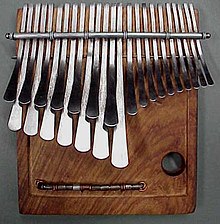Lamellophone
Lamellophones are traditional African music of Sub-Saharan Africa spread various forms of musical instruments belonging to the Zupfidiophonen be counted. Several slats are attached to a board or resonance box and are plucked with the fingers. Lamellophones, which vary from region to region, include mbira with the Shona in Zimbabwe , kalimba with the Chewa and Tumbuka in Malawi , likembe in central Africa, nsansi with the Nyungwe in Mozambique , zanza with the Bena Luluwa in western Kasai , kadongo in Uganda and luliimba near the Makonde in southeastern Tanzania . Outdated names from the colonial era are plucking tongues, thumb piano or kaffir piano .
Most lamellophones have iron tongues. In central Africa, there are also types with tongues from the leaf stalk of raffia as timbrh in Cameroon or with bamboo reeds. For the distribution of the name mbira or mbila, which occurs in several Bantu languages for different lamellophones in southern Africa, see Mbila .
Mood
The tones can be tuned by sliding the slats forwards and backwards. In principle, tuning on any sound system is possible. The tunings, however, are made in terms of intervals rather than pitch steps of a scale. In the case of a diatonic scale, for example, the notes are arranged alternately to the right and left of the long central lamella. If you pluck two slats next to each other, you will hear a consonant third, with three a triad and so on. In free play, secondary dissonances can therefore only be generated by plucking a left and a right lamella, which is why it usually sounds consonant.
Mbira

The mbira consists of a solid wooden board on which - depending on the region and ethnic group, usually 7 to 28, rarely 56 metal tongues of different lengths and strengths are attached. At the bottom right there is a hole into which the little finger of the right hand is inserted as a support. The instrument is played with both hands, making sounds by plucking the tongues with the fingernails of the thumb (down) or forefinger (up). A calabash or a turtle shell is used as a resonance body , and more recently a plastic bowl in which the mbira is attached.
The use of a semicircular, 15 to 20 centimeter long bamboo tube , which is closed at its cut surfaces with suitable wooden inlays, is also quite common. In the absence of special materials, spoon handles are also used for the metal tongues. In addition, metal disks, crown caps and the like are often attached both to the mbira itself and to the sound body, which are set in vibration when playing and generate clinking noises.
A mbira ensemble comprises at least two mbiras and a hosho ( rattle from a calabash). Music is usually played over several hours, often at night.
In the religious game of the Shona in Zimbabwe , the special form of the Mbira Dza Vadzimu helps both the musicians and the tribe members present to go into a trance .
The mbira has been rediscovered as a traditional instrument and incorporated into popular music in Zimbabwe. Ephat Mujuru , Stella Chiweshe , Dumisani Maraire and Hakurutwe Mude , as well as Maurice White (Earth, Wind & Fire) are some of the most famous contemporary interpreters.
The Cuban marimbula is a type of bass lamellophone.
Sansula
A newly developed lamellophone called Sansula , which was developed and patented by the German musician and instrument maker Peter Hokema, has existed since 2001 . The sansula consists of a wooden ring covered with a drum skin, similar to a frame drum, on which the classic sound block of the kalimba is mounted. The result of this construction should be a room-filling sound that is better than the previously known lamellophones. If the instrument is played standing on a table, the sound can be modulated by lifting and lowering the frame slightly to the side; the effect is similar to a low-pass filter.
Kalimbula
Based on the construction and use of an Mbira, Jens Rabenseifner (Hands on Drums) developed the "Kalimbula" as a ceramist and drum maker. A very thin plywood board is mounted on a ceramic body, shaped like a bowl, on which the actual lamellophone is placed. The plywood board takes on the function of the mbira's "clamp stick" when it is played in a pumpkin half. Ceramic as a resonance body (not sintered) has similar properties when used as the pumpkin halves used.
literature
- Gerhard Kubik : Lamellophone. In: Ludwig Finscher (Hrsg.): The music in history and present , Sachteil 5, 1996, Sp. 867-893
- Gerhard Kubik: African and African American Lamellophones: History, Typology, Nomenclature, Performers, and Intracultural Concepts. In: Jacqueline Cogdell DjeDje (Ed.): Turn up the Volume. A Celebration of African Music. UCLA, Los Angeles 1999, pp. 20-57
- Gerd Grupe : The Art of the Mbira Game. The Art of Mbira Playing. Harmonious structure and pattern formation in the lamellophone music of the Shona in Zimbabwe . Hans Schneider Verlag, Tutzing 2004. ISBN 978-3-7952-1148-6
Web links
- The mbira Page - Shona Culture and Resource Guide (English)
- Zimbabwe's mbira - Musical Instrument and mbira organization (English)
Individual evidence
- ^ Ulrich Wegner: African string instruments. Staatliche Museen Preußischer Kulturbesitz, Berlin 1984 (= Publications of the Museum für Völkerkunde Berlin , New Series 41, Department of Ethnic Music , V), ISBN 388609-117-1 , p. 155.
- ↑ Mark Holdaway: THE KALIMBULA - AN ELECTRIC CERAMIC SANSULA. In: Mark Holdaway. Mark Hodaway, accessed August 31, 2016 .



